Numerical Study of Mixed Convection and Heat Transfer in Arc-Shaped Cavity with Inner Heat Sources
Abstract
1. Introduction
2. Physical Model and Numerical Method
2.1. Arc-Shaped Cavity Model
2.2. Basic Governing Equations
2.3. Numerical Method
3. Results and Discussion
3.1. Transient Characteristics
3.2. Flow Structures
3.3. Heat Transfer
4. Conclusions
- When Ra is fixed (Ra = 2.36 × 1012), with the increase in Re, the flow in the arc cavity experiences a transition from turbulent flow to periodic flow and then to a steady flow. The flow period and amplitude decrease with the increase in Re, and the main frequency increases with the increase in Re. The critical Re of transition from weak turbulence to periodic flow is about 6.14 × 106 and 6.15 × 106, and the critical Re of transition from periodic flow to constant flow is between 1.38 × 107 and 1.39 × 107. The flow structure changes from asymmetric and multiple convection cells to symmetric double convection cells.
- There is a linear positive correlation between the heat flux and Re, qt~4.9Re, qcv~4.89Re, qcd~0.001Re. Increasing the number of Re increases the heat convection in the curved cavity structure, and the gap between heat convection and heat conduction also increases with the increase in Re. Nu increases first and then gradually decreases with Re. We found that for 1.75 × 106 ≤ Re ≤ 6.14 × 106, Nu~−0.0059Re, for 6.15 × 106 ≤ Re ≤ 1.1 × 107, Nu~−0.017Re and for 1.31 × 107 ≤ Re ≤ 4.38 × 107, Nu~−0.001Re.
- The average temperature Tm in the middle region of the two heat sources is similar to Nu, while the effective heat coefficient m generally conforms to the rising trend. After the steep rise of Re in the range from 1.14 × 107 to 1.18 × 107, the continued increase in Re has little effect on the removal of waste heat.
Author Contributions
Funding
Data Availability Statement
Conflicts of Interest
Nomenclature
| A | Aspect ratio | T0 | The initial temperature |
| d | The width of the export on the top side of the arc cavity | Tc, Th | The external temperature, the reservoir temperature |
| g | Acceleration of gravity | Tm | The average temperature in the middle region of the two heat sources |
| H | The height of the arc cavity | u, v | Dimensionless horizontal and vertical velocity |
| h1 | The height of the entrance on both sides of the arc cavity | X, Y | Dimensionless coordinate system |
| h2 | The height of trapezoidal heat sources | κ | Thermal conductivity |
| L | The length of the bottom of the arc cavity | ρ | Medium density |
| l1 | The top length of the trapezoidal heat sources | µ | Viscosity coefficient |
| l2 | The bottom length of the trapezoidal heat sources | ω | The magnitude of vorticity |
| m | Effective heat coefficient | β | Coefficient of thermal expansion |
| Nu | Mean Nussert number of the heated wall | θ | Dimensionless temperature |
| P | Dimensionless volume force | τ | Dimensionless time |
| Pr | Prandtl number | Dimensionless temperature difference | |
| qt | Total heat flux in the y-direction | Re | Reynolds number |
| qcv | Averaged convective heat flux in the y-direction | Ra | Rayleigh number |
| qcd | Averaged conductive heat flux in the y-direction |
References
- Plapp, J.E. The analytic study of laminar boundary-layer stability in free convection. J. Aeronaut. Sci. 1957, 24, 318–319. [Google Scholar]
- Patterson, J.; Imberger, J. Unsteady natural convection in a rectangular cavity. J. Fluid Mech. 1980, 100, 65–86. [Google Scholar] [CrossRef]
- Aydın, O.; Guessous, L. Fundamental correlations for laminar and turbulent free convection from a uniformly heated vertical plate. Int. J. Heat Mass Transf. 2001, 44, 4605–4611. [Google Scholar] [CrossRef]
- Xu, F.; Patterson, J.C.; Lei, C. Transient natural convection flows around a thin fin on the sidewall of a differentially heated cavity. J. Fluid Mech. 2009, 639, 261–290. [Google Scholar] [CrossRef]
- Saha, S.C.; Patterson, J.C.; Lei, C. Natural convection boundary-layer adjacent to an inclined flat plate subject to sudden and ramp heating. Int. J. Therm. Sci. 2010, 49, 1600–1612. [Google Scholar] [CrossRef]
- Holtzman, G.A.; Hill, R.W.; Ball, K.S. Laminar natural convection in isosceles triangular enclosures heated from below and symmetrically cooled from above. Heat Transf. 2000, 122, 485–491. [Google Scholar] [CrossRef]
- Welhezi, H.; Ben-Cheikh, N.; Ben-Beya, B. Numerical Analysis of Natural Convection Between a Heated Cube and its Spherical enclosure. Int. J. Therm. Sci. 2020, 150, 105828. [Google Scholar] [CrossRef]
- Usman, M.; Son, J.H.; Park, I.S. A low-Rayleigh transition into chaos for natural convection inside a horizontal annulus at Prandtl number 0.1. Int. J. Heat Mass Transf. 2021, 179, 121658. [Google Scholar] [CrossRef]
- Tasnim, S.H.; Mahmud, S. Laminar free convection inside an inclined L-shaped enclosure. Int. Commun. Heat Mass Transf. 2006, 33, 936–942. [Google Scholar] [CrossRef]
- Eckert ER, G.; Hartnett, J.P.; Irvine, T.F. Flowvisualization studies of transition to turbulence in freeconvection flow. ASME Pap. 1960, 60, 250. [Google Scholar]
- Patterson, J.C.; Graham, T.; Schöpf, W.; Armfields, W. Boundary layer development on a semi-infinite suddenly heated vertical plate. J. Fluid Mech. 2002, 453, 39–55. [Google Scholar] [CrossRef]
- Xu, F.; Patterson, J.C.; Lei, C. Shadowgraph observations of the transition of the thermal boundary layer in a side-heated cavity. Exp. Fluids 2005, 38, 770–779. [Google Scholar] [CrossRef]
- Cui, G.; Pan, C.; Gao, Q.; Li, L.; Wang, J. Experimental study on the influence of groove direction on flow structure in turbulent boundary layer. Chin. J. Theor. Appl. Mech. 2017, 49, 1201–1212. [Google Scholar]
- Wong, N.H.; Heryanto, S. The study of active stack effect to enhance natural ventilation using wind tunnel and computational fluid dynamics (CFD) simulations. Energy Build. 2004, 36, 668–678. [Google Scholar] [CrossRef]
- Su, N.; Peng, S.; Hong, N.; Zhang, J. Experimental and numerical evaluation of wind-driven natural ventilation and dust suppression effects of coal sheds with porous gables. Build. Environ. 2020, 177, 106855. [Google Scholar] [CrossRef]
- Xia, J.; Xin, M.; Zhang, H. Numerical study of natural convection heat transfer in partially open cavity. J. Chongqing Univ. 1989, 12, 20–26. [Google Scholar]
- Chenak, A.K.; Mbaye, M.; Vasseur, P.; Bilgen, E. Mixed convection and conduction heat transfer in open cavities. Heat Mass Transf. 1995, 30, 229–235. [Google Scholar] [CrossRef]
- Khanafer, K.; Vafai, K.; Lightstone, M. Mixed convection heat transfer in two-dimensional open-ended enclosures. Int. J. Heat Mass Transf. 2002, 45, 5171–5190. [Google Scholar] [CrossRef]
- Premachandran, B.; Balaji, C. Mixed convection heat transfer from a horizontal channel with protruding heat sources. Heat Mass Transf. 2005, 41, 510–518. [Google Scholar] [CrossRef]
- Zhang, C.; Yang, M.; Shan, Y.; Zhang, L. Numerical Simulation of Mixed Convection Heat Transfer in an Enclosure with Vertical Isothermal Plate. J. Eng. Thermophys. 2009, 30, 309–311. [Google Scholar]
- Alsabery, A.; Vaezi, M.; Tayebi, T.; Hashim, I.; Ghalambaz, M.; Chamlha, A.J. Nanofluid mixed convection inside wavy cavity with heat source: A non-homogeneous study. Case Stud. Therm. Eng. 2022, 34, 102049. [Google Scholar] [CrossRef]
- Xia, S.; Mostafavi, M.; Alghazali, T.; Sadi, S.; Guerrero, J.W.G.; Suksatan, W.; Toghraie, D.; Khan, A. Numerical investigation of nanofluid mixed convection in a T-shaped cavity by considering a thermal barrier. Alex. Eng. J. 2022, 61, 7393–7415. [Google Scholar] [CrossRef]
- Ali, M.; Akhter, R.; Alim, M. Magneto-mixed convection in a lid driven partially heated cavity equipped with nanofluid and rotating flat plate. Alex. Eng. J. 2022, 61, 257–278. [Google Scholar] [CrossRef]
- Keya, S.; Yeasmin, S.; Rahman, M.; Karim, M.F.; Amin, M.R. Mixed convection heat transfer in a lid-driven enclosure with a double-pipe heat exchanger. Int. J. 2022, 13, 100131. [Google Scholar] [CrossRef]
- Sun, M. Numerical Simulation of Mixed Convective Heat Transfer in a Two-Dimensional Open Chamber. Ph.D. Thesis, Harbin Engineering University, Harbin, China, 2005. [Google Scholar]
- Lei, C.; Armfield, S.W.; Patterson, J.C. Unsteady natural convection in a water-filled isosceles triangular enclosure heated from below. Int. J. Heat Mass Transf. 2008, 51, 2637–2650. [Google Scholar] [CrossRef]
- Li, G.; Ma, H. Numerical simulation of natural convection with Gorelli number laminar flow in a closed chamber. J. Civ. Eng. Manag. 2004, 21, 14–17. [Google Scholar]
- Ma, B.; Wang, Y.; Zhao, X. Effect of inclination Angle on turbulent natural convection heat transfer in a closed square cavity with internal heat source. J. Lanzhou Jiaotong Univ. 2021, 40, 79–87. [Google Scholar]
- Cui, H.; Xu, F.; Saha, S. Transition to unsteady natural convection flow in a prismatic enclosure of triangular section. Int. J. Therm. Sci. 2017, 111, 330–339. [Google Scholar] [CrossRef]
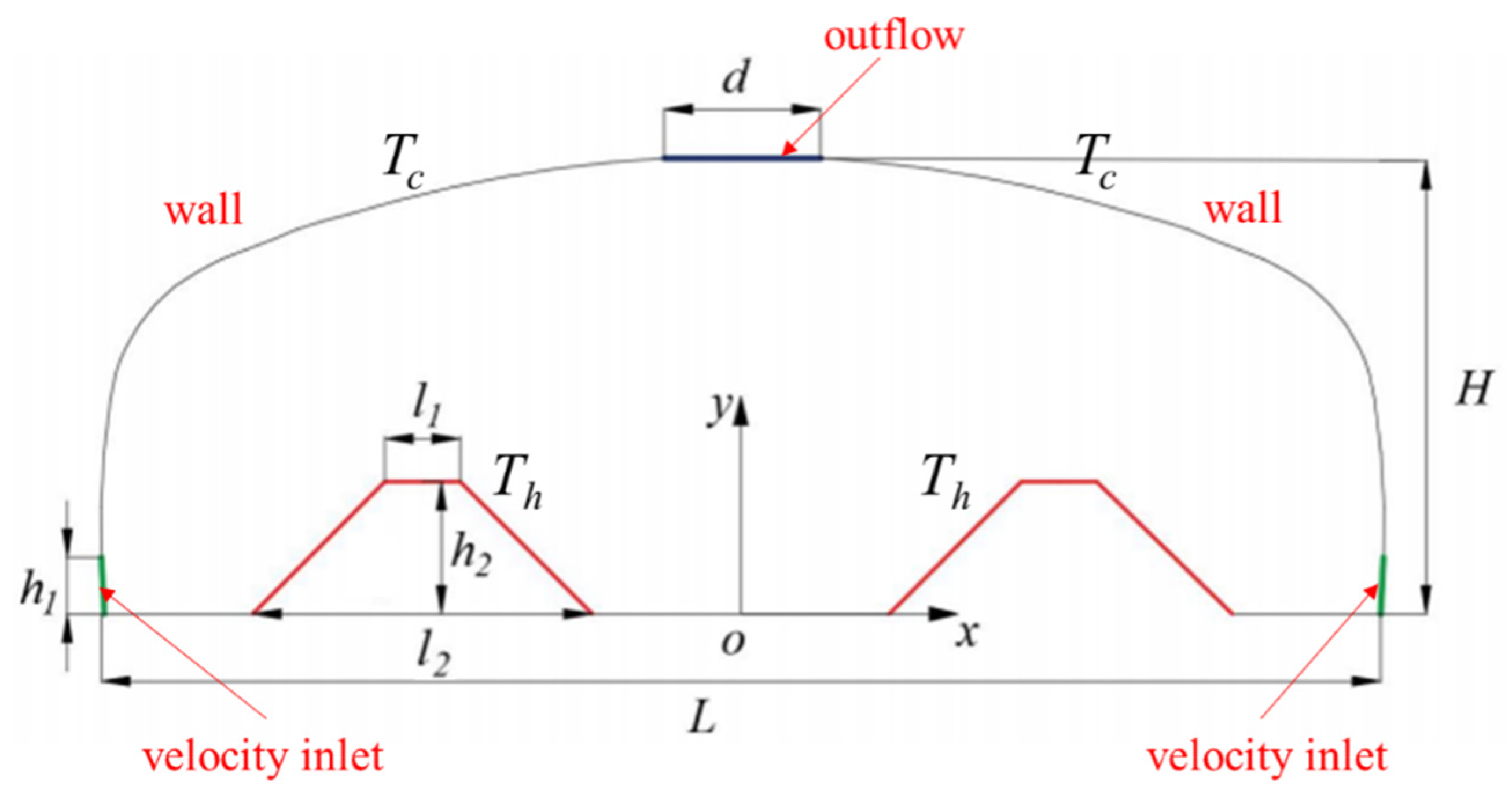
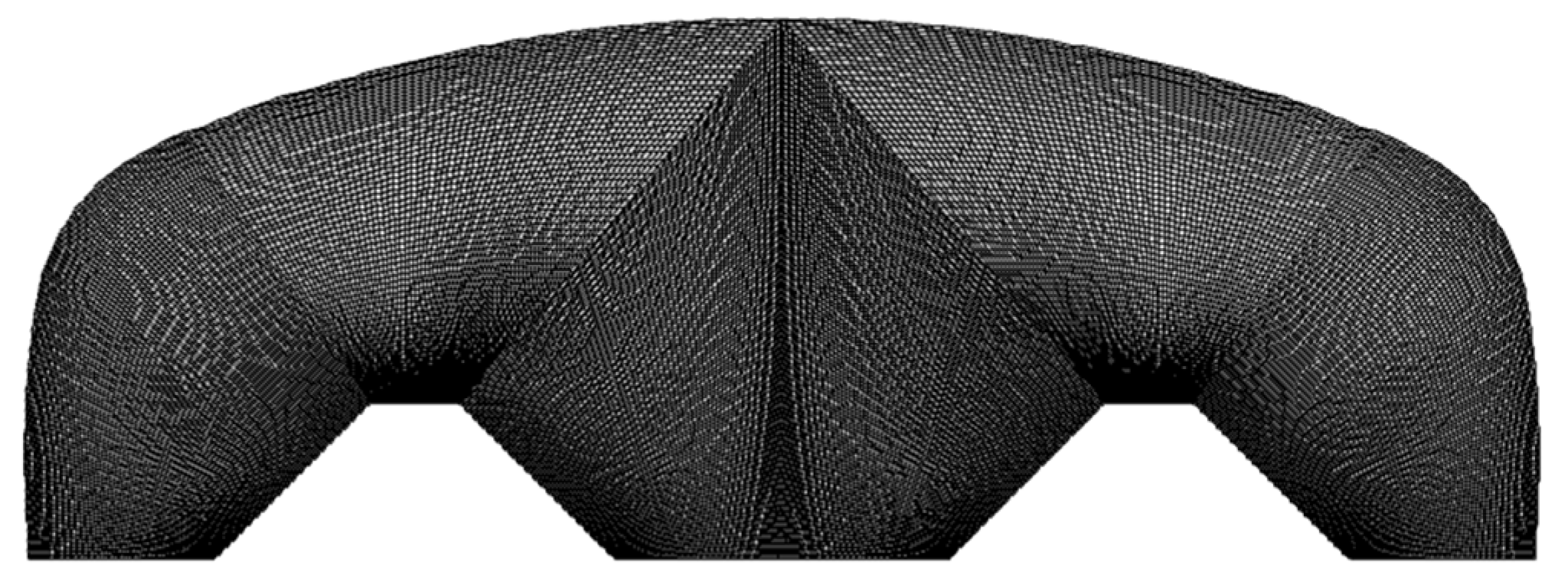

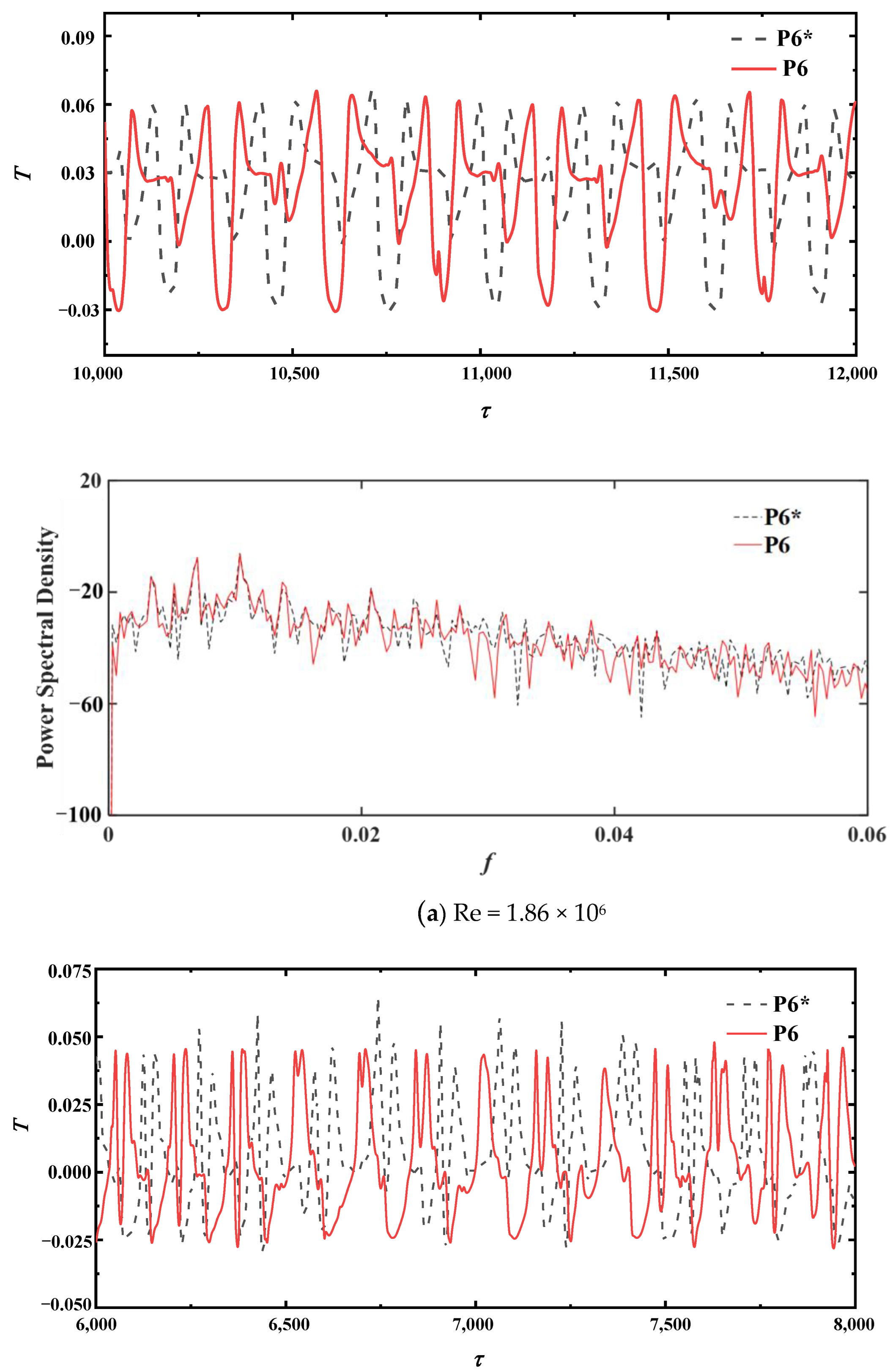
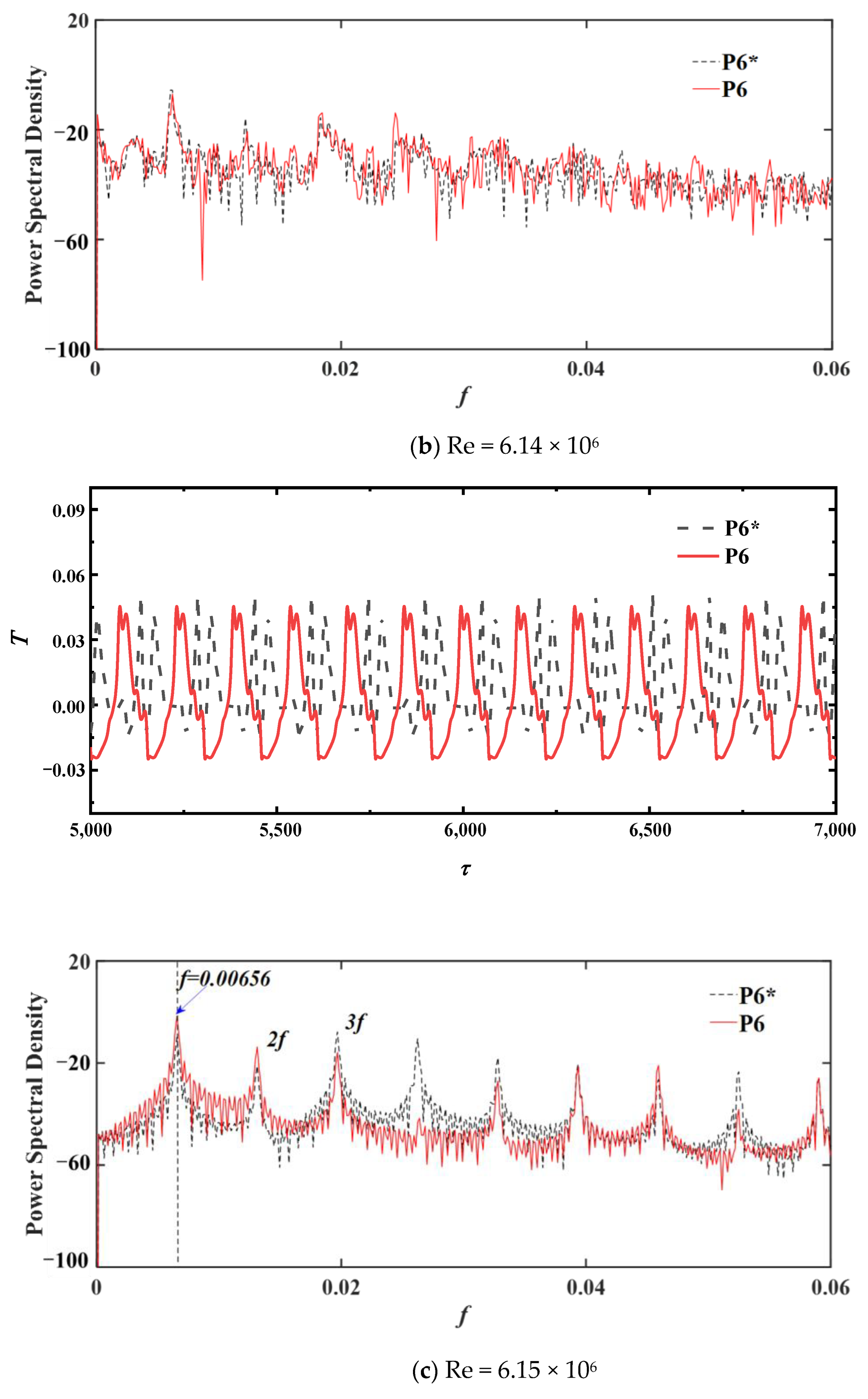

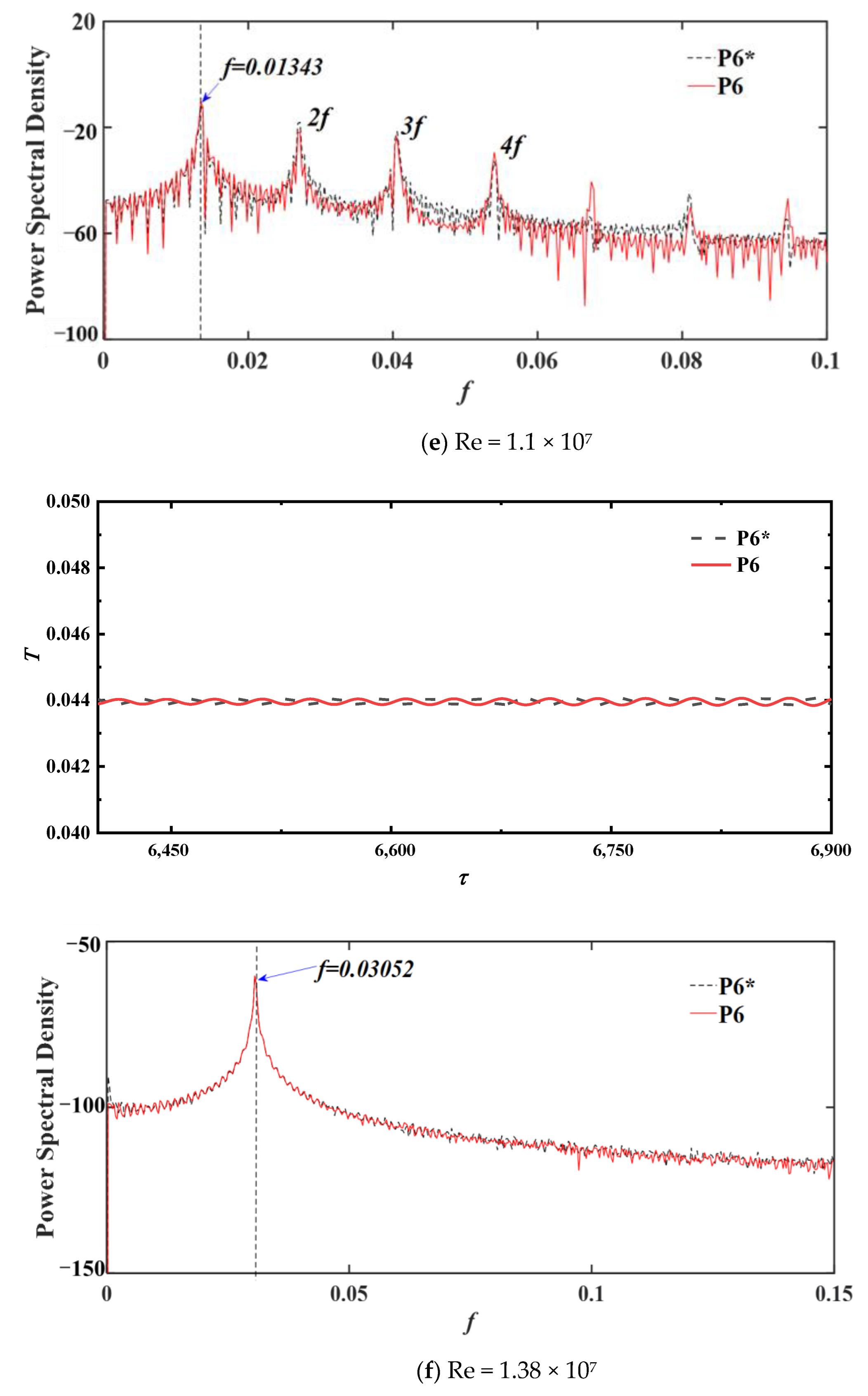
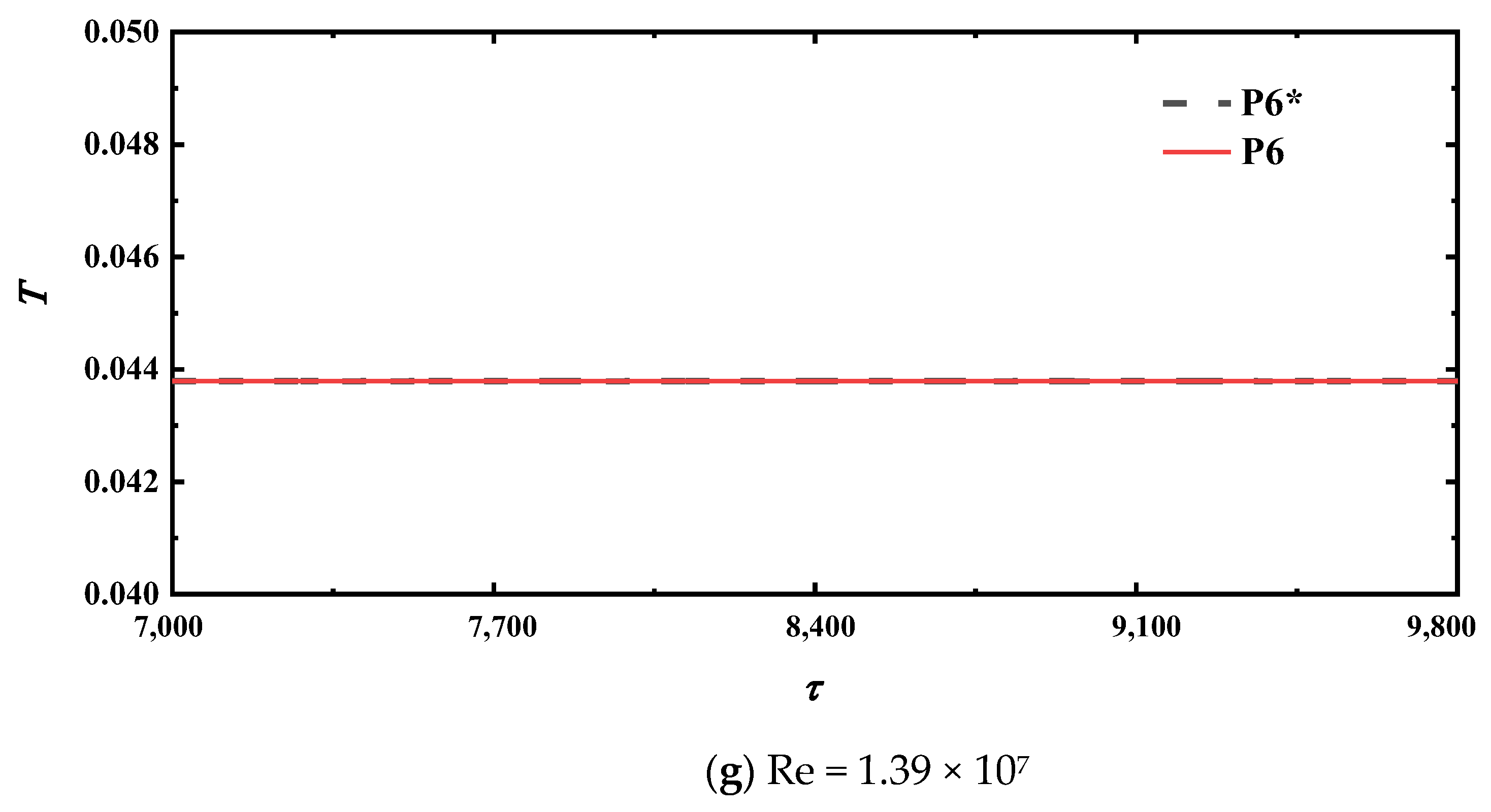
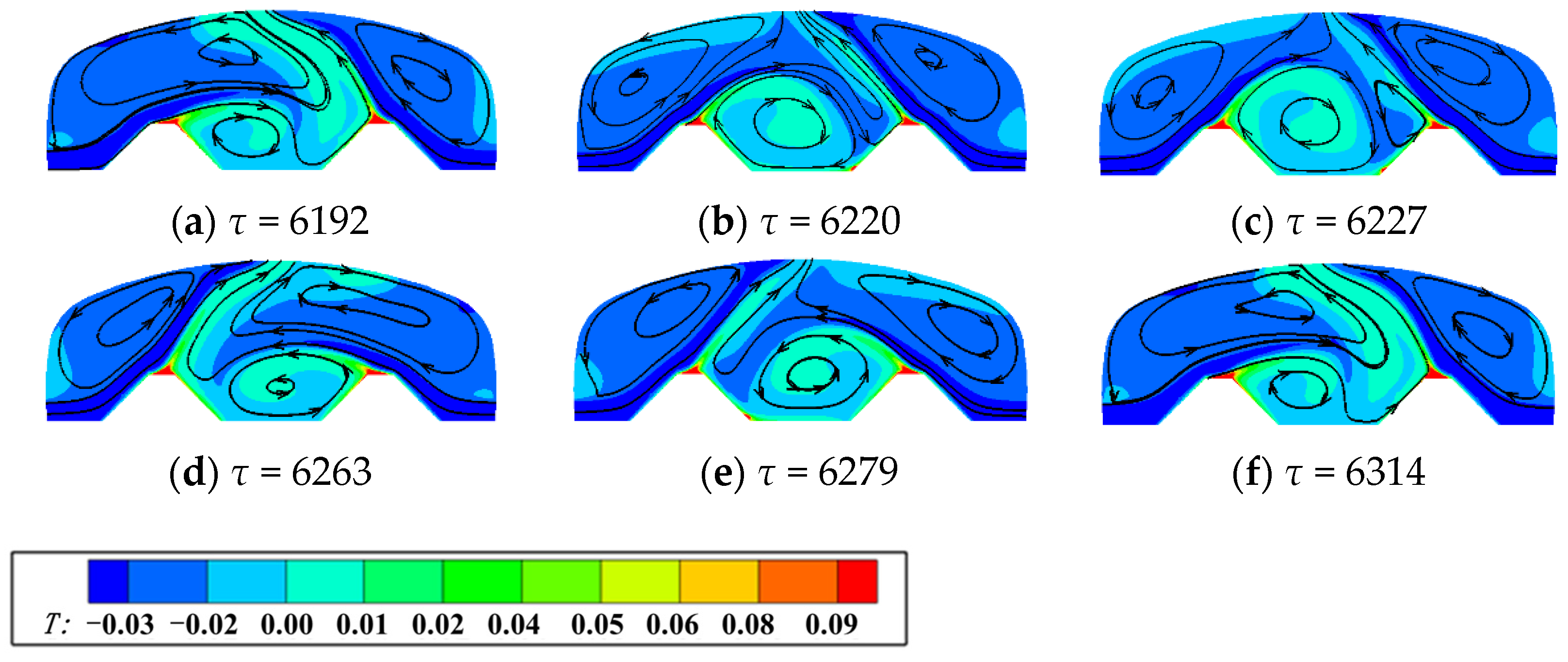
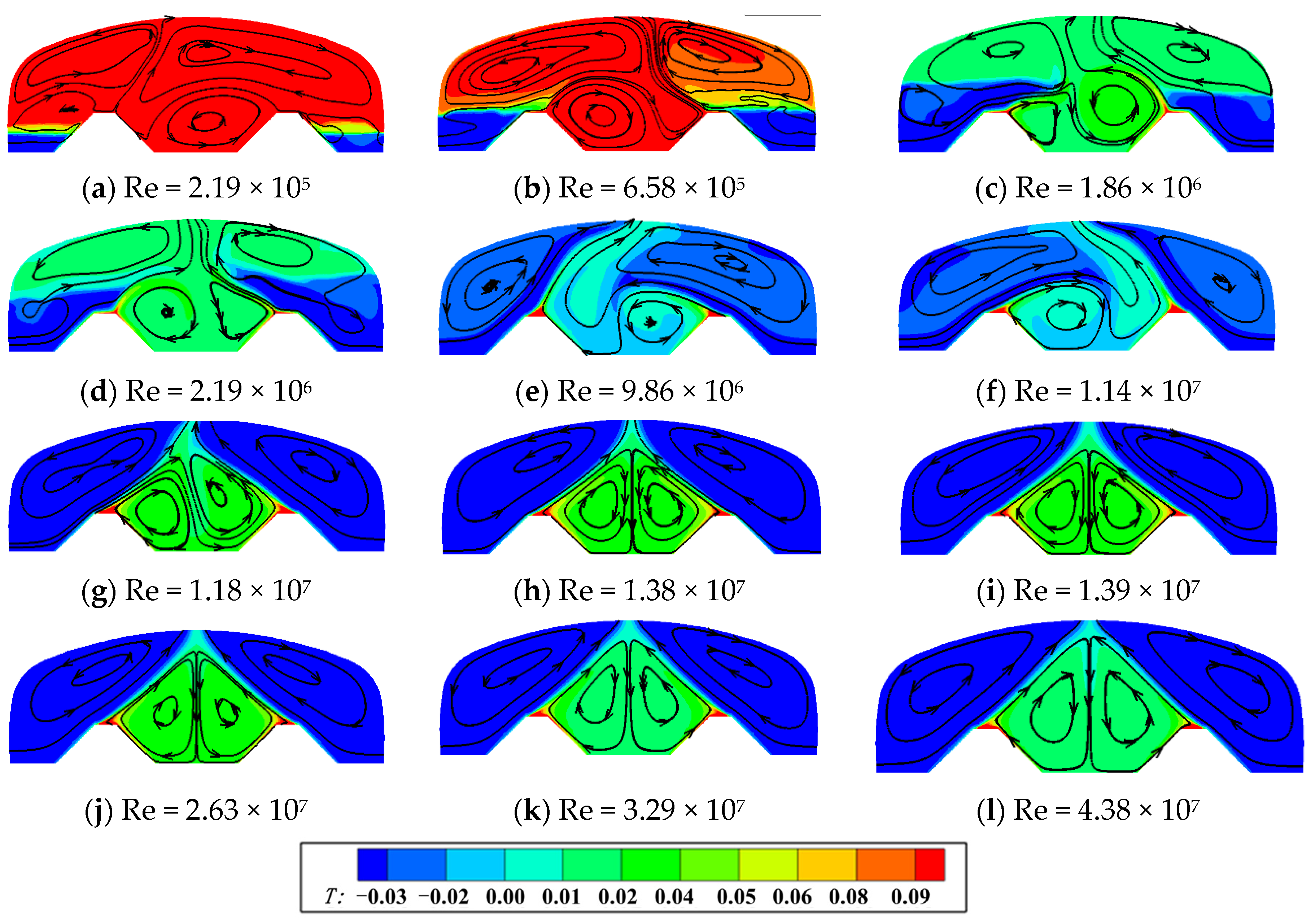
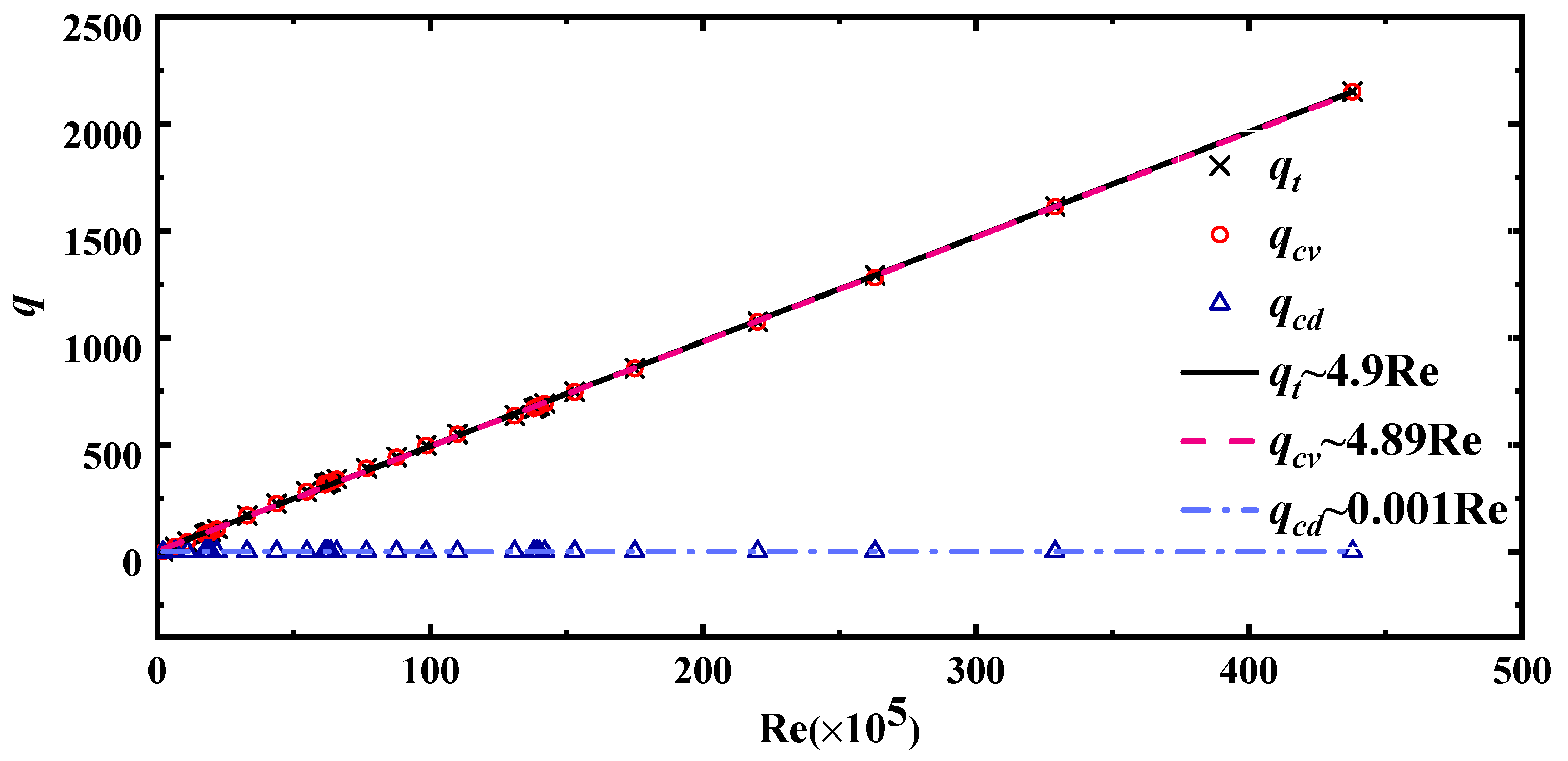

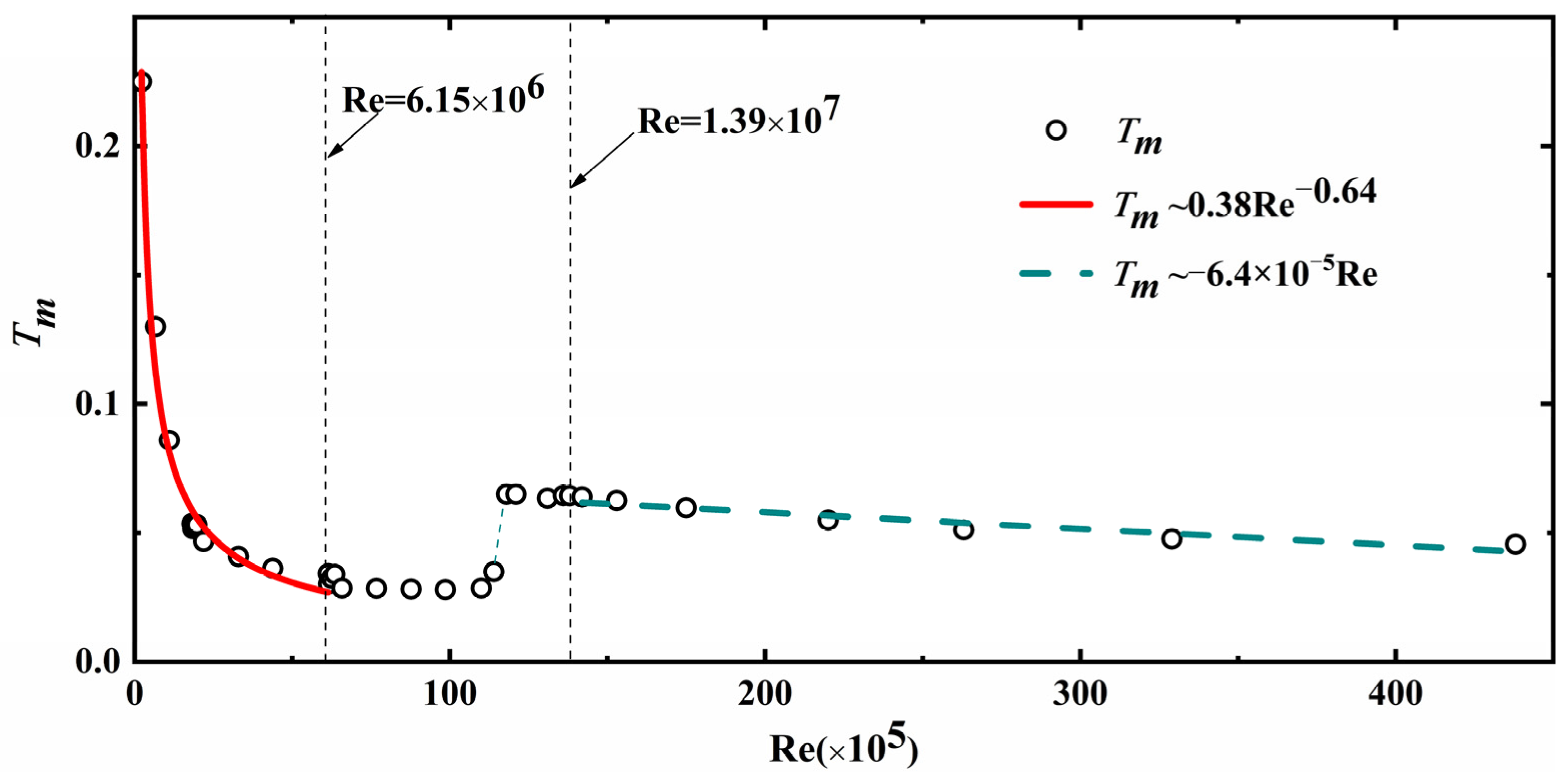
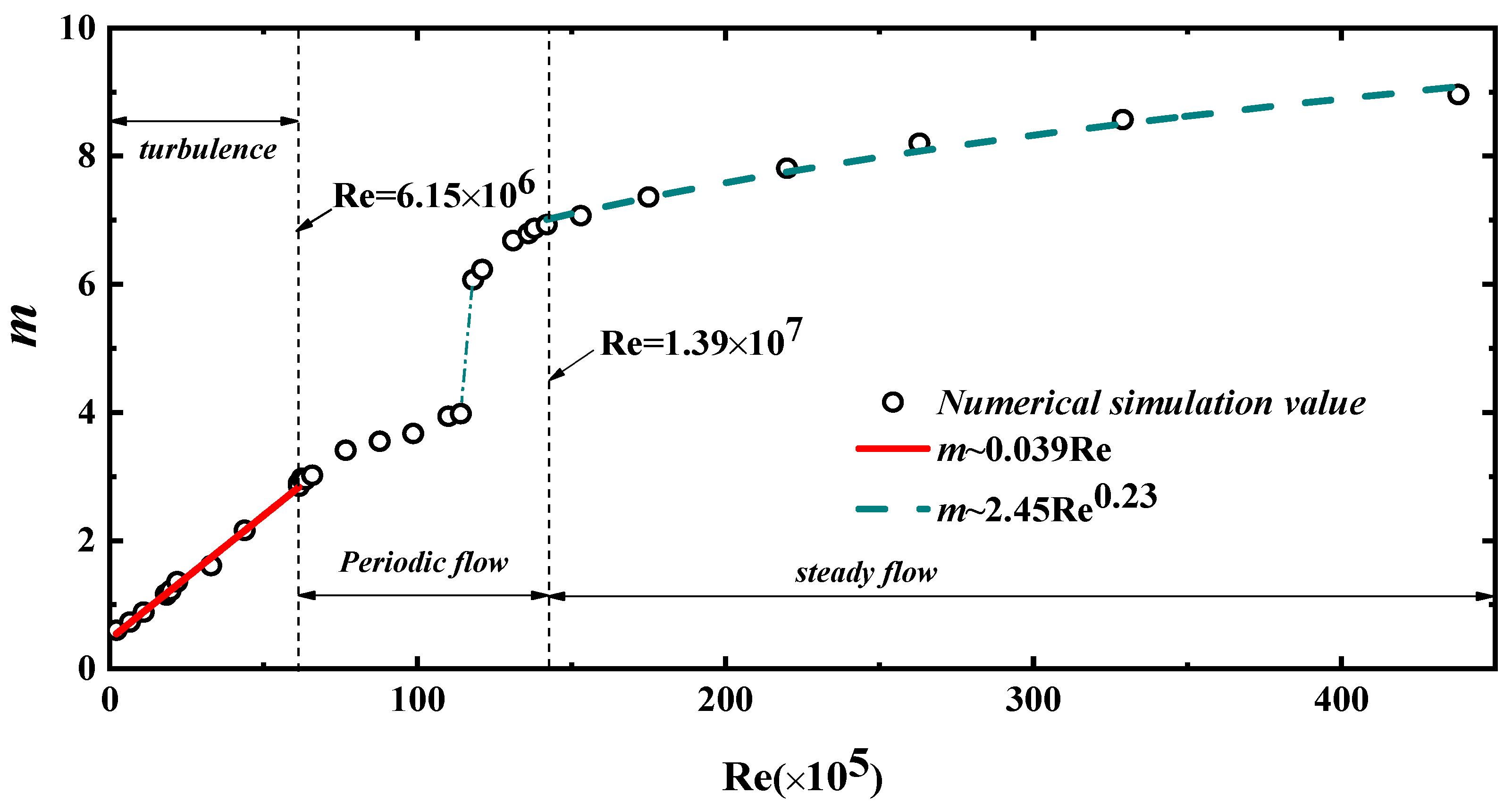
| Number | Mesh Size | Mesh Quantity | Relative Error of Mean Temperature at P6 | Relative Error of Mean Temperature at P6* |
|---|---|---|---|---|
| 1 | 90 × 410 | 40,000 | 2.710% | 1.110% |
| 2 | 170 × 480 | 81,000 | 0.478% | 0.469% |
| 3 | 210 × 495 | 97,000 | —— | —— |
| 4 | 250 × 600 | 160,000 | 0.005% | 0.002% |
| Number | Time Step | Relative Error of Mean Temperature at P6 | Relative Error of Mean Temperature at P6* |
|---|---|---|---|
| 1 | 0.2 | —— | —— |
| 2 | 0.4 | 1.2% | 2.1% |
| 3 | 0.6 | 28.9% | 16.5% |
| 4 | 1.0 | 2.5% | 5.1% |
Disclaimer/Publisher’s Note: The statements, opinions and data contained in all publications are solely those of the individual author(s) and contributor(s) and not of MDPI and/or the editor(s). MDPI and/or the editor(s) disclaim responsibility for any injury to people or property resulting from any ideas, methods, instructions or products referred to in the content. |
© 2023 by the authors. Licensee MDPI, Basel, Switzerland. This article is an open access article distributed under the terms and conditions of the Creative Commons Attribution (CC BY) license (https://creativecommons.org/licenses/by/4.0/).
Share and Cite
Cui, H.; An, H.; Wang, W.; Han, Z.; Hu, B.; Xu, F.; Liu, Q.; Saha, S.C. Numerical Study of Mixed Convection and Heat Transfer in Arc-Shaped Cavity with Inner Heat Sources. Appl. Sci. 2023, 13, 1029. https://doi.org/10.3390/app13021029
Cui H, An H, Wang W, Han Z, Hu B, Xu F, Liu Q, Saha SC. Numerical Study of Mixed Convection and Heat Transfer in Arc-Shaped Cavity with Inner Heat Sources. Applied Sciences. 2023; 13(2):1029. https://doi.org/10.3390/app13021029
Chicago/Turabian StyleCui, Huimin, Haoran An, Wenyue Wang, Zhiming Han, Bo Hu, Feng Xu, Qingkuan Liu, and Suvash C. Saha. 2023. "Numerical Study of Mixed Convection and Heat Transfer in Arc-Shaped Cavity with Inner Heat Sources" Applied Sciences 13, no. 2: 1029. https://doi.org/10.3390/app13021029
APA StyleCui, H., An, H., Wang, W., Han, Z., Hu, B., Xu, F., Liu, Q., & Saha, S. C. (2023). Numerical Study of Mixed Convection and Heat Transfer in Arc-Shaped Cavity with Inner Heat Sources. Applied Sciences, 13(2), 1029. https://doi.org/10.3390/app13021029







